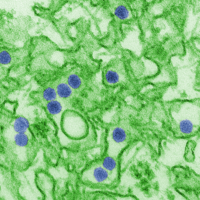
Photo from wikipedia
In this report we consider a data set, which consists of 310 Zika virus genome sequences taken from different continents, Africa, Asia and South America. The sequences, which were compiled… Click to show full abstract
In this report we consider a data set, which consists of 310 Zika virus genome sequences taken from different continents, Africa, Asia and South America. The sequences, which were compiled from GenBank, were derived from the host cells of different mammalian species (Simiiformes, Aedes opok, Aedes africanus, Aedes luteocephalus, Aedes dalzieli, Aedes aegypti, and Homo sapiens). For chemometrical treatment the sequences have been represented by sequence descriptors derived from their graphs or neighborhood matrices. The set was analyzed with three chemometrical methods: Mahalanobis distances, principal component analysis (PCA) and self organizing maps (SOM). A good separation of samples with respect to the region of origin was observed using these three methods. • Background: Study of 310 Zika virus genome sequences from different continents. • Objective: To characterize and compare Zika virus sequences from around the world using alignment-free sequence comparison and chemometrical methods. • Method: Mahalanobis distance analysis, self organizing maps, principal components were used to carry out the chemometrical analyses of the Zika sequence data. • Results: Genome sequences are clustered with respect to the region of origin (continent, country) • Conclusion: Africa samples are well separated from Asian and South American ones.
Journal Title: Current computer-aided drug design
Year Published: 2019
Link to full text (if available)
Share on Social Media: Sign Up to like & get
recommendations!